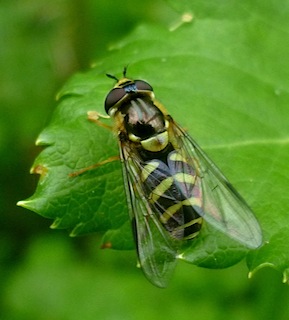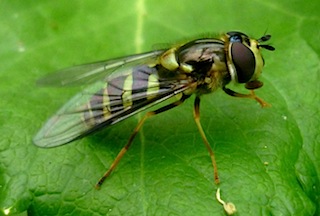 Spring and summer usher in hoverflies – there are so many species that only a handful have common names.
Spring and summer usher in hoverflies – there are so many species that only a handful have common names.
Photo: Andy Pay
Scientific name: Dasysyrphus albostriatus
What to look for:
- Colouring: Three pairs of oblique yellow bars on the black abdomen. Two grey stripes on the thorax. Black front edge to the wing.
- Size: Wingspan ≤ 9 mm
- When: Spring and a second generation in late summer.
- Where: Woodland edges and rides, nectaring on flowers in sunny spots.
- Similar species: Didea species are similar, also having oblique bars, but the markings are broader.
 The oblique yellow and black bars and the two paler grey stripes on the thorax are the distinctive features of this pretty hoverfly of sunny woodland rides. Like others in the Dasysyrphus genus, there is a black edge along the front of the wing. You can spot it nectaring on flowers in the spring and again in the late summer to early autumn, when there is a second generation.
The oblique yellow and black bars and the two paler grey stripes on the thorax are the distinctive features of this pretty hoverfly of sunny woodland rides. Like others in the Dasysyrphus genus, there is a black edge along the front of the wing. You can spot it nectaring on flowers in the spring and again in the late summer to early autumn, when there is a second generation.
You’ll be hard-pressed to spot the larvae, however. They are cleverly camouflaged to blend in with bark of the branches on which they live, feasting on aphids.
 There are over 280 species of hoverfly in Great Britain, many of which (though not all) are characterised by their highly recognisable bright yellow and black patterning, mimicking wasps and bees (known as Batesian mimicry) and therefore, although harmless, deterring predators. Their ability to hover in flight, either when nectaring or, in males, when searching/waiting for a mate, is also a very familiar feature. There are seven Dasysrphus species recorded in the UK.
There are over 280 species of hoverfly in Great Britain, many of which (though not all) are characterised by their highly recognisable bright yellow and black patterning, mimicking wasps and bees (known as Batesian mimicry) and therefore, although harmless, deterring predators. Their ability to hover in flight, either when nectaring or, in males, when searching/waiting for a mate, is also a very familiar feature. There are seven Dasysrphus species recorded in the UK.
Did you know…?
…Globally, there are some 6000 species of hoverfly in 200 genera.
…Like some other hoverflies, Dasysyrphus species have hairy eyes. You won’t see that in the field, though – take a photo and enlarge it to see if you can spot the tiny hairs.
More information and references:
Ball, S. and Morris, R., 2013. Britain’s Hoverflies: An Introduction to the Hoverflies of Britain. Princeton University Press, Woodstock, Oxfordshire.
Published: April 2015
Author: Amanda Scott
Photos: Andy Pay
